
Guests
- Samira Sierraone of five listed plaintiffs in a class-action lawsuit against the NYPD.
- Amali Sierraone of five listed plaintiffs in a class-action lawsuit against the NYPD.
- Sonyi LopezDemocracy Now! video news fellow.
- Joshua Moskovitzlawyer representing the plaintiffs in a class-action lawsuit against the NYPD.
New York City has reached a multimillion-dollar settlement with peaceful protesters who were violently “boxed in” or “kettled” by NYPD officers during a Black Lives Matter demonstration in response to the police murder of George Floyd in 2020. As part of the settlement, over 300 people who were trapped by police and assaulted with batons and pepper spray, then detained or arrested at a June 4, 2020, protest in the neighborhood of Mott Haven, will each receive $21,500 — believed to be the largest class-action settlement in a case of mass arrest. We are joined by three people who were at the Mott Haven protest: Samira and Amali Sierra, sisters who are two of the five listed plaintiffs, and Democracy Now! video news fellow Sonyi Lopez, whose footage of the protest was used in a Human Rights Watch report that condemned the NYPD’s actions as “serious violations of international human rights law.” In addition, we speak to Joshua Moskovitz, one of the lawyers representing the plaintiffs.
Transcript
AMY GOODMAN: This is Democracy Now!, democracynow.org, The War and Peace Report. I’m Amy Goodman.
We begin today’s show here in New York, where the city has agreed to a multimillion-dollar settlement with peaceful protesters who were violently “boxed in” or “kettled” by New York police officers during a Black Lives Matter demonstration two weeks after the police murder of George Floyd in 2020. As part of the settlement, over 300 people who were trapped by police and assaulted with batons and pepper spray, then detained or arrested at a June 4th, 2020, protest, will each receive $21,500 — believed to be the largest class-action settlement in a case of mass arrest. The arrests took place in the South Bronx. A Human Rights Watch investigation said the NYPD’s conduct that day amounted to “serious violations of international human rights law.”
PROTESTER 1: We are currently trapped at 136th and Brook Avenue, since 7:45. They are pushing us!
PROTESTER 2: Oh my god! Oh!
PROTESTER 1: They are pushing us!
PROTESTER 2: They’re pushing us!
PROTESTER 1: They are pushing us!
PROTESTER 2: They’re pushing us!
PROTESTER 1: They are pushing us! They are pushing us! Stay calm! Stay calm! Stay calm! What are you doing?
POLICE OFFICER: Move! Move! Move! Move!
AMY GOODMAN: That’s part of a video report produced by Human Rights Watch that raised awareness about the kettling that took place that day. This is another clip.
IDA SAWYER: As the marchers headed down Willis Avenue, more than 50 police officers blocked the street.
PROTESTER 1: Yo, we gonna go around. We gonna go around.
IDA SAWYER: The march redirected down 136th Street. And in the final minutes just before the 8:00 curfew, instead of allowing or even directing the marchers to disperse, the NYPD diverted its bicycle officers to block the marchers just as they reached the intersection of 136th and Brook Avenue.
PROTESTER 2: What did I do?
PROTESTER 3: Why are you pushing, bro?
POLICE OFFICER: Mobile fence line one! Move the crowd!
POLICE OFFICERS: Move back! Move back!
PROTESTER 4: Go that way! Go that way! Go that way!
PROTESTERS: Let us through! Let us through! Let us through! Let us through!
IDA SAWYER: And from behind the march, a line of officers blocked the protesters from turning back. It’s a tactic called kettling.
AMY GOODMAN: That’s from a Human Rights Watch investigation of the NYPD kettling in the South Bronx June 4th, 2020, that was the focus of the historic settlement announced this week. In response to concerns raised at the time, the police said their crackdown was preplanned. This is New York City Police Commissioner, at the time, Dermot Shea.
COMMISSIONER DERMOT SHEA: And we had a plan which was executed nearly flawlessly in the Bronx. This wasn’t, again, about protest; this was about tearing down society.
AMY GOODMAN: Meanwhile, NYPD’s Strategic Response Group has continued to target nonviolent protesters, and this week dozens of people testified at the New York City Council about their abusive tactics. The NYPD refused to show up.
For more, we’re joined by three people who were at the protest in the Bronx in June 2020. Sonyi Lopez was filming the protest. She’s currently a video news fellow here at Democracy Now! Her footage was used in the Human Rights Watch report. Also with us, Samira Sierra and Amali Sierra. They’re sisters. They’re among the five listed plaintiffs. And joining us, Joshua Moskovitz, one of the lawyers representing the plaintiffs.
We welcome you all to Democracy Now! Let’s begin with the plaintiffs, with Samira and Amali. Samira, why don’t you start off by talking about what this protest was about, two weeks after George Floyd’s murder, where you marched and what happened?
SAMIRA SIERRA: Good morning.
The protest was during the uprisings right after George Floyd’s murder. And simply, we were exercising our human rights, our civil rights, and we were demonstrating and standing up against all of the racial injustice that happens day in and day out in this country.
AMY GOODMAN: And, Amali, that’s your older sister Samira. Talk about your decision. I mean, it was brave to go out. We’re talking about June of 2020. This is at the height of the COVID pandemic, at the time of the killing, the police killing of George Floyd. Did you expect what happened to happen? And then explain what happened in just one block of the South Bronx, when you were stopped by police.
AMALI SIERRA: Yes, so, to your point, this was in the midst of a global health crisis. We had been in the pandemic for a few months at this point. This was not the first of the protests that we attended that summer. It was the first that we had attended in our home, in the South Bronx. And the energy that day, from the beginning of the protest, was very tense. And so, the very short protest that we partook in on June 4th reflected just that. It was very tense. It was met very violently. However, we were very peaceful in our demeanor, while also making sure to exercise our right, that we are entitled to, and express the anger and the frustration that we felt because of the violence that Black and Brown people are constantly met with in the United States of America. And so, although our message was very clear and we were very intentional in expressing our frustration and our anger, we were — at any time, we were not violent. We were very peaceful. And so, it was met very violently, and we were not expecting at any point to be met with all the aggression that we were by the NYPD and by the SRG specifically.
AMY GOODMAN: I mean, the terrifying image, Samira, of the police blocking you in, kettling you, and telling you to move where there’s no place to go. And then explain what the police did.
SAMIRA SIERRA: Sure. So, we were very strategically guided down 136th Street. And when we — as we were walking down towards Brook Avenue, we were blocked off by a line of officers on both ends of the street, so off of Willis Avenue and on Brook Avenue. And there was a commander in a white shirt who continued to direct the officers to move in at the same time. We were boxed in. We were kettled. And we were also, like, squished. Our bodies were squished, like squished up against each other. There were people that — I mean, you just passed that footage where, you know, it was terror. We were terrified for our lives. People couldn’t breathe. People were fainting. I have never in my life felt the amount of fear that I felt that day.
AMY GOODMAN: Sonyi Lopez, it’s great to have you on screen, as you’re usually behind the scenes and filming — and that’s what you were doing that day — a Democracy Now! video news fellow now. But at the time, you were filming this protest. Explain what you saw. And, I mean, when you see the police, the first arrests are of the legal and the medics? And they’re very clear about what they’re doing. “Move ahead and arrest them,” they said.
SONYI LOPEZ: Right, Amy. I was there. I’m actually a South Bronx resident. I live in Mott Haven. And this was the second peaceful protest that I participated in in my neighborhood. And it was absolutely peaceful. What I saw when the police came down this hill on 137th Street and kettled folks, I saw police coming down the hill on bikes at rapid speed. And as soon as that happened, literally like a second later, they started blocking people off with their bikes and pushing people with these bikes, attacking medics, like you said, Amy, attacking lawyers, people that were there, legal aids, to help community members and protesters alike in case things like this happen, right? But we were not expecting that.
Luckily, I managed to run away, but before I could run away, I was able to document and film. As you said, HRW and SITU — Human Rights Watch — were able to use the video that I recorded that day. But it was frightening. I had never been so scared in my — and fearful in my own neighborhood. And I’ll never forget that. I wasn’t able to leave my home for months after that, like other protesters, and felt unsafe. And it was just so traumatizing that day.
AMY GOODMAN: I want to bring the lawyer into this conversation, Joshua Moskovitz, the lawyer for the plaintiffs. Joshua, talk about the unit of police. I mean, we just played Dermot Shea, the police chief at the time in New York, saying this was all preplanned by the police. And in this Human Rights Watch reporting, which uses a lot of Sonyi’s footage, you see they deliberately go after the legal and the medical teams first. And they’re very clear. One of the police officers said, “It’s fine” — it said something — I think he had “police legal” on his shirt, and he said, “It’s fine to arrest the legal observers,” who were considered essential workers at the time, right? They were allowed to be out. Explain who this team of police are.
JOSHUA MOSKOVITZ: Right. So, the NYPD’s Strategic Response Group, or SRG, are a paramilitary organization within the NYPD that are used to police protest events, nonviolent protest events like we saw in Mott Haven. They’ve come under appropriate scrutiny for their violent tactics that are primarily used to suppress nonviolent free speech activity like we saw in Mott Haven.
This was no accident. This was a planned operation. And what’s unique about the Mott Haven operation is that it was planned by the highest-level officials within the police department. Terence Monahan, the chief of department, which is the highest-ranked — highest uniformed ranking officer within the police department, was personally present at Mott Haven. So were the executive officer, the commanding officer and the bureau chief that oversee the SRG unit. They had a plan that day, and, as the commissioner said the next day, it was executed, in their view, flawlessly.
AMY GOODMAN: I mean, it’s just astounding. And you see them separate out one of the leaders of the protest with a bullhorn. They push her aside. In fact, she was one of the first to be arrested.
JOSHUA MOSKOVITZ: That’s right. I mean, there is no question in the world that the plan that day was to instill fear in people so that they would stop protesting. This was not a violent uprising. This was a peaceful protest. In fact, there were people attending the protest who lived in the South Bronx who were members of the mayor’s Cabinet. The commissioner of the community affairs for Mayor de Blasio was there personally, because he lived in the South Bronx, Marco Carrión. He talked about what happened that day and described the sentiment at the protest as closer to a candlelight vigil. The purpose of this operation was to instill fear in people.
AMY GOODMAN: You know, it’s very interesting that on Wednesday the City Council held a long-planned, repeatedly delayed oversight hearing on the Strategic Response Group, that was involved with this. No one from the NYPD showed up, citing ongoing litigation. Your response to this? And talk about this historic settlement, in the country, for what took place in the South Bronx.
JOSHUA MOSKOVITZ: Well, as you said, this is a historic settlement. As far as we can tell, this is the largest per person class-action mass arrest settlement in the country. And we think that that is appropriate, given the extreme violence that we saw carried out by the NYPD during the operation. And the size of the award that the city agreed to, we think, reflects an acknowledgment or understanding that what happened that day was unconstitutional, it was immoral, and it should never happen again. We hope that the NYPD has taken this to heart and will reform the operations and, frankly, never use the SRG for policing protest events in the future.
But the other aspect of this case that I think often gets overlooked is that this happened in the South Bronx. This happened in New York Congressional District 15, which is 97% people of color. It’s also one of the poorest congressional districts in the entire country. This operation wasn’t carried out in Manhattan, where there were protests. It wasn’t carried out in Brooklyn, where there were protests that summer. There was a choice made at the highest levels of the NYPD to carry out this operation in the South Bronx. And that fact is part of what has led to the Human Rights Watch finding this to be a human rights violation. And we’re proud of our clients in pursuing this litigation and pursuing the result that they achieved here for people who weren’t able to get lawyers but were there that day and who were injured.
AMY GOODMAN: Amali and Samira — Amali, you’re 25. Samira is 30 now. This was three years ago. What does this settlement mean for each of you? Amali, let’s begin with you.
AMALI SIERRA: This settlement is larger than myself. I believe that the settlement allows for individuals who were there that day, the hundreds of individuals that were there that day, the opportunity to come forward, the opportunity to be recognized and acknowledged, based off of the abuse that they endured that day, and hopefully an opportunity to also heal. It was very traumatic, and trauma looks very different for every individual. And so, I hope that this encourages all of the individuals that were unable to represent themselves to come forward. And that is why it is extremely crucial and very important to be a representative of a class action of this magnitude, not just for myself but for the greater good and for all of the people that were unable to represent themselves.
AMY GOODMAN: And, Samira, your response? And also the fact that no police officer was charged that day, and also there wasn’t an official apology, but you did have this financial settlement.
SAMIRA SIERRA: Right. The settlement, to me, means that the City of New York is being held accountable for organizing the highest level of the NYPD, which is the Strategic Response Group, and holding them accountable for flawlessly executing excessive force in the South Bronx, which is my home.
AMY GOODMAN: Josh, very quickly —
SAMIRA SIERRA: It also means to —
AMY GOODMAN: Oh, go ahead.
SAMIRA SIERRA: It also means to me that, you know, they’re being held accountable for the violation of human rights of Black and Brown folks in this country, one of many. We have a long way to go, but it feels really good, for the lack of a better word, to know that there is some accountability.
AMY GOODMAN: Joshua, very quickly, there are other lawsuits, right? This is not the only one, this class action.
JOSHUA MOSKOVITZ: That’s right. There are other lawsuits that are still proceeding, one, in fact, interestingly, brought by New York State Attorney General’s Office against the City of New York seeking injunctive relief to reform the police department’s policing of protest events.
AMY GOODMAN: And finally, Sonyi Lopez, you were not kettled in. You escaped that. But can you talk about the effect on you, as a journalist who was filming, seeing these people kettled in, being beaten by the police?
SONYI LOPEZ: Absolutely, Amy. Me, beyond being a journalist, I’m a community member. I grew up in this area, so it hurt to see my community being beat like this. And, you know, in response to the class-action lawsuit, it’s great that people are getting monetary — you know, being compensated monetarily, but we also need some trauma — some healing, maybe therapy offered to folks like myself who ran away, who were able to get away from this.
I also wanted to add, really quickly, Amy, that Mott Haven Families, a community group with children and adults, protested in front of the 40th Precinct demanding accountability and asking the question, “What happened on June 4th?” for months on end, and had no response, no answer from the NYPD or accountability from the city. And meanwhile, a small jail — a jail was being built in Mott Haven across the street from my former middle school while all of this was happening. So, this is just a traumatic event, and I think that we need to remember that people are still healing from this to this day.
AMY GOODMAN: Well, Sonyi Lopez, I want to thank you for joining us on screen today, Democracy Now! video news fellow, filmed the protest in 2020; Samira and Amali Sierra, named plaintiffs in this historic class-action lawsuit; and Joshua Moskovitz, lawyer for the plaintiffs.

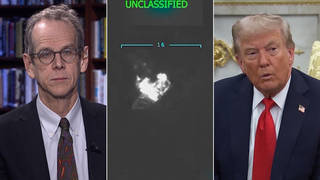

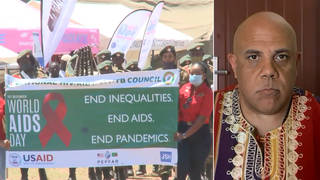
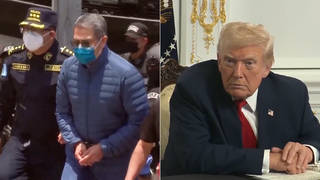





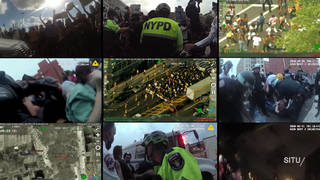
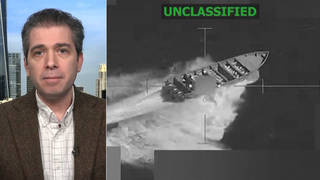
Media Options